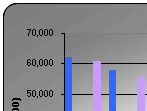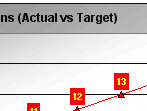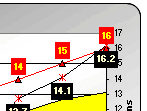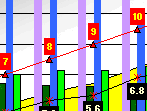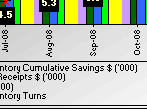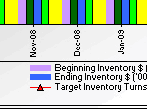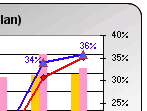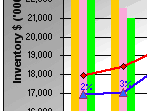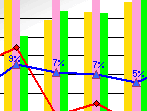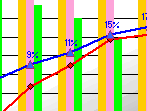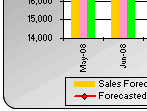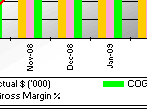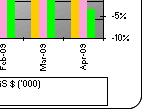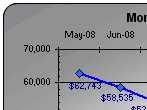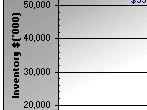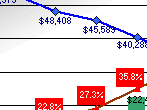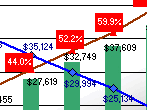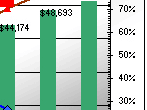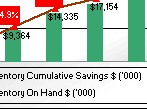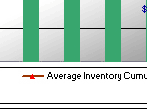About Me
Excel VB Programming (VB6)
Excel Spreadsheet Formulas
Excel VB.NET Programming
Access Programming (2003)
Inventory Key Performance Indicators (KPI), scorecard and dashboard
You can skip by going straight to the individual resource of KPI : Inventory, Order Fulfillment, Procurement, Outsourcing, Logistics & Transportation, Production, Manufacturing, Supply Chain Managemt
There is no comprehensive list of KPIs that can be specific to each type of industry. Caution is needed whenever an organization is identifying its performance measures. Measures drive employee behavior towards achieving the organizational goals. Organizations must understand the basic concepts that differentiate scorecards from dashboards and analytics, and KPIs from other business performance indictors.
What exactly is it? Developed by Kaplan & Norton in 1996, there are many
definitions to it. Primarily, it is:
■ a strategic planning and management system used to
align business activities to the vision and mission statements of an
organization.
■ a strategic concept that involves creating a set of
measurements from four perspectives - financial goals and performance,
customer requirements and success factors, internal business processes
and operational excellency, and learning and growth.
These four measurement perspectives must be linked, consistent and mutually reinforcing. Some of specific areas of measurements are:
-
Financials - Return On Investment (ROI), Growth Profit Margin, Cashflow, Working Capital, inventories costs, inventory turnovers, Sales, etc.
-
Customer - Customer service level and satisfaction, retention, acquisition, profitability, market share.
-
Internal business process - involves refinement in critical internal processes and value chain in innovation (how well products are designed to meet customer's needs), operations (materials availability, product quality, process efficiency, utilization, cycle time, costs, forecast errors, excess and obsolescence, scraps), and aftersales service (warranty, repairs, and handling defects and product's returns).
-
Learning and Growth - involves in human capital investment (employee retention, training, skills, productivity, morale), systems (critical market information and customer's needs gathered by sales and marketing, that help company to strategize and plan for future product design and as well as other segments of business opportunities), and organizational capabilities (R&D, technologies, market responsiveness, talented managerial depth).
■ Both represent a way to track
results.
■ Both use traffic lights, dials, sliders and other visual
aids.
■ Both have targets, thresholds and alert messages.
■ Both provide linkage or drill down to other metrics and
reports.
The difference comes from the context in how they are applied. Scorecards are intended to be strategic. Dashboards are primarily for data visualization; they display what is happening during a time period. Most organizations begin with identifying what they are already measuring and construct a dashboard dial from there. However, dashboards do not communicate why something matters. In contrast, a scorecard does provide the information lacking in dashboards. A scorecard additionally answers questions by providing deeper analysis, drill-down capabilities, traffic light alert messaging, and forecasting for inferences of performance potential to determine motivational targets. Scorecards do not start with the existing data, but rather they begin with identifying what strategic projects to complete and core processes to improve and excel in. The selection and validation of the correct or best KPIs is a constant debate.
Here are some guidelines for understanding the differences:
■ Scorecards chart progress toward strategic objectives. A scorecard displays periodic snapshots of performance associated with an organization’s strategic objectives and plans. It measures organizational activity at a summary level against pre-defined targets to see if performance is within acceptable ranges. Its selection of KPIs helps executives communicate strategy to employees and focuses users on the highest priority projects, initiatives, actions and tasks required to execute plans.
There are two key distinctions of scorecards: (1) Each KPI must require a predefined target measure; (2) KPIs should be comprised of both project-based KPIs (e.g., milestones, progress percentage of completion) and process-based KPIs (e.g., percent on-time delivery against customer promise dates).
■ Dashboards monitor and measure processes. A dashboard, on the other hand, is operational and reports information typically more frequently than scorecards and usually with measures.2 Each dashboard measure is reported with little regard to its relationship to other dashboard measures. Dashboard measures do not directly reflect the context of strategic objectives.
Key Performance Indicators are quantifiable measurements, agreed to beforehand, that reflect the critical success factors of an organization. KPIs are long-term considerations. The definition of what they are and how they are measured do not change often. The goals for a particular Key Performance Indicator may change as the organization's goals change, or as it gets closer to achieving a goal. It is also important to define the Key Performance Indicators and stay with the same definition from year to year. For examples, will sales be recorded for the KPI at list price or at the actual sales price? Do you take inventory value at different periods of the months and sometimes with different costs when calculating inventory turns?
Here are some guidelines on how you should go about setting goals. First, make sure you understand exactly what it is your measuring. What drives this measure? What causes failure? Where do you need improvement? Once you can answer these questions, you're in a better position to set your goals. Benchmarking is one other way to set your goals. Also, you should practice SMART goals which are:
- Specific: Provide enough detail so that there is no question on what is being measured and no question how the metric is calculated. You should be specific as to the measurement, goals and responsible people/department.
- Measurable: Here is where you use your metric. Make sure you have a reliable system in place that will accurately measure your performance.
- Attainable: Will the Supply Chain projects you have scheduled for the year produce results that will achieve your goal? The person setting the goal and the person responsible for achieving the goal should agree with the target. If results are un-attainable or unrealistic, they will have a de-motivating effect on your employees.
- Realistic: Don't plan to do things if you are unlikely to follow through. Better to plan only a few things and be successful rather than many things and be unsuccessful. Your Supply Chain goals should be challenging, but realistic in relation to the improvement projects you have in place.
- Time frame: Identify when your targeting to hit your goal.
Below is a list of the commonly used KPIs and
the subset of formulas for managing inventory, measuring inventory
productivity, evaluating operational efficiencies, profits and growth.
| Cost of Goods Sold (COGS) | = | (Beginning Inventory + Net Purchases) - End Inventory | |||||||||
* COGS is an income
statement figure which reflects the cost of obtaining raw materials and
producing finished goods that are sold to consumers.
|
|||||||||||
| Inventory Turnover | = |
Cost of Goods Sold during the past 12 months |
|
Average Inventory at Cost during the past 12 months |
||
| A ratio showing how many times a company's inventory is sold and replaced over a period. | ||
| Gross Profit Margin (GM) | = | (Sales Revenue - Cost of Goods Sold) |
| Sales Revenue | ||
|
Gross margins reveal how much a company earns taking into consideration
the costs that it incurs for producing its products and/or services, and
is expressed as a percentage. Gross margin is a good indication of how
profitable a company is at the most fundamental level. Companies with
higher gross margins will have more money left over to spend on other
business operations, such as research and development or marketing. |
||
| Gross Margin Return On Investment | = | (GM% x sales turnover) / (1 - markup %) |
| Gross Margin Return On Inventory | = | [(Unit Selling Price of an Item - Unit Cost of an Item) X Annual Demand for the item] / Average Inventory Cost of the product |
| Weeks of Inventory (WOI) | = | Ending Inventory Balance |
| Average weekly sales for a given period of time | ||
| Days of Inventory (DOI) | = | Ending Inventory balance |
| (Average weekly sales for a given period of time) x 7 | ||
| or alternatively, | ||
| Days of Inventory (DOI) | = | COGS/ 365 days (it gives you the number of days of stock on-hand) |
| Weeks of Inventory (WOI) | = | COGS/ 52 weeks (it gives you the number of weeks of stock on-hand) |
| Months of Inventory (WOI) | = | WOI/4.33 |
| some call it Inventory Months of Supply | ||
| or alternatively, | = | Inventory On Hand / Average Monthly Usage |
| Sell through % | = | units sold / (units sold + on hand inventory) |
| Stock Sales Ratio | = | Beginning of month $ Stock / Sales for period |
| BTP Shrinkage | = | Difference between book and physical inventory |
Table 12.1 below shows the several
inventory KPI measurements over a period of 12 months. A company I went
for an interview told me that his business unit was tied down with too
much inventory dollars of more than $64 millions and they were
experiencing a poor inventory turnover of less than 6.0 turns compared
to 16 turns the supply chain was well-performing a few years ago. I made
out a plan to help the supply chain to improve the inventory turnover in
a steadily progressive manner from 5.0 turns to 16.0 turns, measuring
from May-2008 up to April-2009. Together with the goal of inventory
turnovers are also the plan to improve sales forecast accuracy, to lower
the cost of goods sold while at the same time ensuring customer service
levels are met continually without risk of stockout, to improve target
gross profit margin, to reduce DOI (Days of inventory) and overall
average inventory dollars cumulative saving.
Assuming time is into year 2009 and actual data are available for measuring inventory management performance. A considerable improvement in inventory turnover from 4.2 turns in May-08 to 16.2 turns in Apr-09 equate to a huge reduction in actual inventory of $50,740,000, or in another word, 81.5% of actual inventory dollars cumulative saving. Over the 12 months period it had also freed up $50.7 millions dollars in cash for the other important businesses. In terms of DOI, it also translates into a reduction in the average days of inventory on-hand from 73 days to 22.8 days. Even with a small 0.3 turns improvement from May-08 to July-08 had resulted in a reduction in average days of inventory on-hand from 73 days to 52.1 days, from the initial capital outlay of $64.24 millions in May-07 beginning inventory level. It was able to free up nearly 10 million dollars ($9.93 M) for other business investment over just a 3-months period. It is not enough to re-emphasize the power of maximizing inventory turns as you can see there were also simultaneous improvement efforts made in other areas of inventory control - beginning inventories, net purchases, ending inventories, cost of goods sold, month-over-month inventory $ cumulative saving.
With tightened control on purchasing which had reduced excess and surplus purchases, reduced safety stock level, or reduced the min. and max-order-quantities buying for the slow-usage materials, getting suppliers improved in supply lead time, and hence the costs of goods sold were able to reduce steadily over the measuring period. The lower COGS that was maintained with the different planning strategies, coupled with thje steadily increasing growth in sales revenue over the period, together had contributed to the higher gross profit margin from 2% to 36% over the 12 months.
For any level and list of inventory items, this inventory scorecard can be applied to different product lines, multi-location warehouses, different material classes and material categories, existing Service Level Agreement programs, and also for manufacturing site that has production plan with built-to-stock model.
DOWNLOAD this worksheet example as shown in Table 12.1.
| Month | Target Inventory Turns | Actual Inventory Turns | Sales Forecast $ ('000) | Sales Actual $ ('000) | Beginning Inventory $ ('000) | Purchase Receipts $ ('000) | Ending Inventory $ ('000) | COGS $ ('000) | Forecasted Gross Margin % | Actual Gross Margin % | Average Inventory On Hand $ ('000) | Average Inventory Cumulative Savings $ ('000) | Actual Inventory Cumulative Savings $ ('000) | Average Inventory Cumulative % Saving | Actual Inventory Cumulative % Saving | Average Days of Inventory On Hand | Actual DOI On-Hand |
| May-08 | 5 | 4.2 | 23,500 | 22,460 | 64,240 | 19,940 | 62,220 | 21,960 | 7% | 2% | 62,743 | - | - | - | - | 73.0 | 86.9 |
| Jun-08 | 6 | 4.3 | 22,882 | 21,545 | 60,937 | 17,890 | 57,852 | 20,975 | 8% | 3% | 58,535 | 4,208 | 4,368 | 6.7% | 7.0% | 60.8 | 84.9 |
| Jul-08 | 7 | 4.5 | 22,900 | 21,960 | 55,372 | 16,930 | 52,285 | 20,017 | 13% | 9% | 53,379 | 9,364 | 9,935 | 14.9% | 16.0% | 52.1 | 81.1 |
| Aug-08 | 8 | 5.3 | 20,874 | 22,990 | 53,020 | 16,580 | 48,220 | 21,380 | -2% | 7% | 48,408 | 14,335 | 14,000 | 22.8% | 22.5% | 45.6 | 68.9 |
| Sep-08 | 9 | 5.6 | 21,325 | 22,786 | 50,045 | 16,230 | 45,000 | 21,275 | 0% | 7% | 45,589 | 17,154 | 17,220 | 27.3% | 27.7% | 40.6 | 65.2 |
| Oct-08 | 10 | 6.8 | 21,845 | 23,980 | 46,864 | 15,900 | 39,934 | 22,830 | -5% | 5% | 40,288 | 22,455 | 22,286 | 35.8% | 35.8% | 36.5 | 53.7 |
| Nov-08 | 11 | 7.4 | 22,542 | 23,800 | 40,980 | 15,360 | 34,680 | 21,660 | 4% | 9% | 35,124 | 27,619 | 27,540 | 44.0% | 44.3% | 33.2 | 49.3 |
| Dec-08 | 12 | 8.4 | 22,980 | 23,720 | 36,076 | 14,755 | 29,835 | 20,996 | 9% | 11% | 29,994 | 32,749 | 32,385 | 52.2% | 52.0% | 30.4 | 43.5 |
| Jan-09 | 13 | 9.5 | 23,230 | 23,540 | 30,758 | 14,040 | 24,900 | 19,898 | 14% | 15% | 25,134 | 37,609 | 37,320 | 59.9% | 60.0% | 28.1 | 38.4 |
| Feb-09 | 14 | 12.7 | 23,250 | 23,765 | 24,456 | 13,725 | 18,529 | 19,652 | 15% | 17% | 18,569 | 44,174 | 43,691 | 70.4% | 70.2% | 26.1 | 28.7 |
| Mar-09 | 15 | 14.1 | 23,845 | 24,980 | 17,489 | 13,020 | 14,000 | 16,509 | 31% | 34% | 14,050 | 48,693 | 48,220 | 77.6% | 77.5% | 24.3 | 25.9 |
| Apr-09 | 16 | 16.2 | 23,930 | 24,248 | 14,950 | 12,080 | 11,480 | 15,550 | 35% | 36% | 11,519 | 51,224 | 50,740 | 81.6% | 81.5% | 22.8 | 22.5 |
|
|
|||||||||||||||||
|
Figure 12.1 Measuring monthly Inventory Turns |
|||||||||||||
|
Figure 12.2 Measuring Cost of Goods Sold and Gross Profit Margin |
|||||||||||||
|
Figure 12.3 Measuring monthly cumulative inventory dollars saving |
|||||||||||||
The following is an good example of a dashboard that you can use to effectively track, measure, and evaluate the various categories of the inventory against predefined goals on a weekly basis instead of once every month which are normally too late to react to problems and underperforming results. It evaluates the three levels of inventories - accessible inventory, WIP inventory and the restricted inventory. It also includes the planning and purchasing areas of responsibilities which evaluate the many important issues on inventory productivity and operational efficiencies, and the KPIs in the last section including Customers Service Level, Inventory Turns, Gross Profit Margin and so on. When your organization has the monthly goals on inventory turns, gross profit margin and other KPIs, this weekly dashboard will allow you to timely track and evaluate all the underperforming KPIs before it becoming too late to do anything towards the end of the months.
Over-shipment value would have to be excluded from the inventory total value because that is the extra stock shipped out without being captured in the computer system. The units of measurement are in multiple of million $, percentage and number. The frequency of evaluating the performance is weekly and monthly for some KPI. The "traffic lights" color-coding symbols are used to measure the weekly performance status. I have developed an Excel VBA macro (generic enough and no hardcode) to automatically color-code the status in the column "Trend" so that managers don't need to waste unnecessary time on putting in the color symbols but they can use their valuable time to go through the misperformance with the various stakeholders. You can easily easily develop an Workbook_SheetBeforeDoubleClick Change Event code so that when you double-click on any of the performance measurement indicator (ie. any cell in second column under header "Measurement"), it will bring out the detailed worksheets where the different process owners had reviewed and based their weekly results on. To include such Analytics macro will save you much time because you can quickly and effectively go through the causes and effects analysis with the respective stakeholders. Ask all the stakeholders to save their analysis files in a single designated shared directory with specified subfolder names. This way it is a lot easier for you simply to assign a Constant to the designated directory path. If you need my help on writing the code for the analytics, you can write to me. Further down below is the syntax for this dashboard.
You can DOWNLOAD this dashboard worksheet as shown below which also has the code in VB Module.
|
||||||||||||||||||||||||||||||||||||||||||||||||||||||||||||||||||||||||||||||||||||||||||||||||||||||||||||||||||||||||||||||||||||||||||||||||||||||||||||||||||||||||||||||||||||||||||||||||||||||||||||||||||||||||||||||||||||||||||||||||||||||||||||||||||||||||||||||||||||||||||||||||||||||||||||||||||||||||||||||||||||||||||||||||||||||||||||||||||||||||||||||||||||||||||||||||||||||||||||||||||||||||||||||||||||||||||||||||||||||||||||||||||||||||||||||||||||||||||||||||||||||||||||||||||||||||||||||||||||||||||||||||||||||||||||||||||||||||||||||||||||||||||||||||||||||||||||||||||||||||||||||||||||||||||||||||||||||||||||||||||||||||||||||||||||||||||||||||||||||||||||||||||||||||||||||||||||||||||||||||||||||||||||||||||||||||||||||||||||||||||||||||
When declaring your variables for cell values, positions of columns and rows, you want to make sure you are using the correct data types. If you have problem following my code below, you may want to refer my other page on creating If..Then..Else Conditional Statements and Loops Decision.
Below I give you a long list
of the various Performance Indicators that are commonly used and some
are the standard measurements being used across the various industries.
You can study them, and decide how your people are going to effectively
collect and munching raw data, setting criteria, automate
analysis, and implement control plan before you want to include them in
your process dashboard in addition to the KPIs I have shown you in table
above. I segment them by the various business unit functions -
Inventory, Order Fulfillment, Supply Chain, Procurement, Manufacturing,
Production, Outsourcing, Shipping.
Inventory
Inventory is a list
for goods and materials, or those goods and materials themselves, held available
in stock by a business. Inventory are held in order to manage and hide from the
customer the fact that supply delay is longer than delivery delay, and also to
ease the effect of imperfections in the manufacturing process that lower
production efficiencies if production capacity stands idle for lack of
materials.
Inventory
Service Level
Service Level KPI is to measure the level of service performed by Inventory or
Stock Control in fulfilling their customer (user) requirement. It is reflected
by the percentage of quantity or value fulfilled toward total quantity or value
requested (demand) during the period of reporting.
Independent Demand Ratio
For manufacturers that
also supply replacement parts and consumables this metric helps to define the %
mix of demand for an item from independent (outside sources) vs dependent
(inside sources). The ratio is calculated by dividing the unit usage for
customer orders by the total unit usage of the item from all sources (work
orders, sales samples, destructive testing, inventory adjustments, etc.).
Early Receipts to MRP Date
(required date)
Early receipts to MRP date - This
is a measure on your Planning efficiencies. Some planners or warehouse personnel
may request that the material be brought in long before the plant/operators need
the parts. Reasons for doing so may be quality, lead time variance, buffer stock
etc. Early receipts to MRP produce higher levels of inventory that are not
required yet. In a way, this is at the other end of the scale than JIT. Measure:
MRP due date vs Receive to Dock (stores) date.
Inventory Lead Time
Lead time is the length of
time it takes to obtain inventory from suppliers.
Assertive continuous
improvement programs should be in place to support a decrease in
inventory count errors.
The formula is: (book inventory - counted
inventory)/book inventory
Unit Cost Per
Batch
Unit Cost per batch = (Cost/Quantity) for each batch
Primarily used in FIFO (First In First Out) Method
Assumes an inventory of non-unique goods (that is, every one is similar to every other one) Generally preferred inventory valuation method. Assumes inventory is sold in the order that it is stocked, with the oldest goods sold first and the newest goods sold last. Uses the unit cost per batch of acquired/produced goods, and counts the inventory backwards from the newest batch.
Inventory Value
Inventory
Value = Average Unit Cost x Units of Current Inventory
Inventory Carrying Cost
It is measure by
Inventory Carrying Rate X Average Inventory Value. [
See this example ]
GMROI (Gross Margin
Return on Inventory)
GMROI = [(Unit Selling Price of an Item -
Unit Cost of an Item) X Annual Demand for the item] / Average Inventory
Cost of the product.
Note that Unit Inventory Value tells you what it costs you to make the product. The Unit Selling Price - Unit Inventory Value tells you the Margin.
Stock Cover
Stock cover is the length
of time that inventory will last if current usage continues.
Obsolescence for Raw
Material, WIP, and Finished Goods Inventory
Inventory reserves taken due to obsolescence and scrap and includes
products exceeding the shelf life, i.e. spoils and is no good for use in
its original purpose (do not include reserves taken for Field Service
Parts).
Field Service
Parts Obsolescence
Reserves taken due to obsolescence and scrap. Field Service Parts are
those inventory kept at location usually outside Manufacturing plant
i.e., distribution center or warehouse.
Order Fulfillment
Fill Rates
(Order Fill Rate, Line Item Fill Rate, Unit Item Fill Rate)
It calculates the service level between 2 parties and is a measurement
of shipping performance expressed as a percentage of the total order. It
calculates the amount of order lines shipped on the initial shipment
versus the amount of lines ordered, and has to take into consideration the
requested delivery date.
Order Fill Rate or
Service Level
It is measured as
Orders filled/Orders Requested.
The percentage of your deliveries to customer delivered in full (ie.
number of orders, lines, or units delivered in full divided by the total
number of orders customer requested). For example: 5 lines (=10 units)
not delivered in full from one order of 10 lines (=200 units) = 0% Order
Service Level.
Line-Item Fill Rate
Total Line items filled / Total Lines shipped in time per order per
period. For example: 5 lines (=10 units) not delivered in full from one
order of 10 lines (=200 units) = 50% Line-Fill Service Level.
Unit-Item Fill Rate
Total Units items filled / Total Units shipped in time per order per
period. For example: 5 lines (=10 units) not delivered in full from one
order of 10 lines (=200 units) = 95% Unit-Fill Service Level.
Lines Late to
Promise
Lines shipped after promised ship date
Lines Late to
Schedule
Lines shipped after scheduled ship date
Order Fulfillment Cycle Time
Order Fulfillment Cycle Time is a
continuous measurement defined as the amount of time from customer
authorization of a sales order to the customer receipt of product.
Customer order Promised Cycle Time
The anticipated or agreed upon cycle time
of a Purchase Order. It is gap between the Purchase Order Creation Date
and the Requested Delivery Date. This tells you the cycle time that you
should expect (NOT the actual).
Number of deliveries with past
due goods issue date
Number of Deliveries where the Goods Issue date (date it should leave the
premises to reach customer on time based on transit time) is equal to or less
than today’s date.
Perfect Order Measure /
Fulfillment
The error-free rate of each stage
of an order. Error rates are captured at each stage (order entry, picking,
delivery, shipped without damage, invoiced correctly) and multiplied together.
% of Backorders
The number (or percentage) of
unfulfilled orders. A backorder is an unfilled customer order, or demand
(immediate or past due) against an item whose current stock level is
insufficient to satisfy demand. Can also measure Aged
Backorders which are backorders in past-due time buckets based on the
Requested Delivery Date/Requested Ship Date.
Net Booked Order Value
Value of booked order lines less the value of booked
return lines for the sale of products but not services.
Past Due Schedule
Lines
Number of booked order lines with past due scheduled ship date.
Past Due Schedule
Value
Value of open order lines with past due scheduled ship date.
Sell Through %
It refers to the percentage of the inventory
received from factory or distribution depot that is actually sold to the
consumer.
Percentage of units sold
during a period =
units sold / (units sold + on hand inventory).
This can also be described as
Units sold
divided by Beginning Inventory Qty.
Supply chain
Days
Inventory
Outstanding (DIO)
It measures cash
investment tied up in
inventory that will impact Working
Capital. A decrease is an improvement, an increase a deterioration. DIO is closely tie with Inventory Turns metric. DIO is
generally good if Inventory Turns numbers are increasing.
DIO = Inventory /
(Net Sales / 365)
Note:
Many companies use Cost of Goods Sold instead of Net Sales when
calculating DPO and DIO.
Days Sales Outstanding
(DSO)
Sellers want to shorten their cash conversion cycle by measuring DSO. It
measures the average number of days that a company takes to collect
revenue after a sale has been made. A low DSO number means that it takes
a company fewer days to collect its accounts receivable. A high DSO
number shows that a company is selling its product to customers on
credit and taking longer to collect money. Thus, a decrease in DSO
represents an improvement, an increase a deterioration.
DSO = Account Receivables / (Net Sales / 365)
Days Payable Outstanding (DPO)
It measures the total time it takes a business to pay back its
creditors.
Buyers want to delay payment for as long
possible by extending
DPO.
DPO = Account Payables / (Net Sales / 365)
Days Working Capital (DWC)
Days of Working Capital (or the overall
cash conversion cycle ) is the average number of days a firm takes to
convert working capital into sales revenue. The fewer the number of
days, the more efficient the use of working capital. Thus, the lower the
number of days, the better. DWC = (
Account Receivables + Inventory – Days Payable Outstanding) / (Net
Sales / 365)
% of time spent
picking back orders
Number of hours spent on picking back
orders as a percentage of working hours.
Sales order by FTE
This indicator measures the number of
customer orders that are processed by full time employees per day. This
helps evaluate the workforce cost per order.
Scrap value %
Scrap value as a percentage of production
value.
Manufacturing
Schedule Adherence
Manufacturing Schedule
Adherence = (|Scheduled Production - Actual Production|)/Scheduled
Production.
which is the absolute variance of actual production to scheduled
production.
When manufacturing over or
under produces against plan, either service level or inventory investment is
adversely affected.
Assertive continuous improvement programs should be in place to decrease the
variance.
Inventory Accuracy
Most Advanced Planning Systems calculate net
inventory requirements. If the book inventory used as the basis for these
calculations has a high error, the net inventory requirements generated will not
reflect the true inventory needs. The inventory error should be factored into
the safety stock calculation to protect service levels from variance in
inventory due to inventory count accuracy.
Assertive continuous improvement
programs should be in place to support a decrease in inventory count errors.
Formula is:
(book inventory - counted
inventory)/book inventory
Inventory Carrying
Costs
Inventory Carrying Cost = Inventory
Carrying Rate X Average Inventory Value
[ see above
]
Inventory Carrying
Rate
This can best be explained by the example below…. 1. Add up your annual
Inventory Costs: Example: $800k = Storage, $400k = Handling, $600k =
Obsolescence, $800k = Damage, $600k = Administrative, $200k = Loss (pilferage
etc), and $3,400k Total
1. Divide the Inventory Costs by
the Average Inventory Value: Example: $3,400k / $34,000k = 10%
2. Add up your: 9% = Opportunity Cost of Capital (the return you could
reasonably expect if you used the money elsewhere) 4% = Insurance 6% = Taxes 19%
3. Add your percentages: 10% + 19% = 29% Your Inventory Carrying Rate = 29%
Direct Product Cost
Sum of costs associated with
manufacturing a specific product.
Direct Labor Cost
Sum of costs associated with
payment of employees, insurances, taxes, etc.
Direct Material Cost
Sum of costs associated with
acquisition of raw material and support material.
Cost of goods sold (COGS)
Cost of Goods Sold includes all
expenses directly associated with the production of goods or services the
company sells (such as material, labor, overhead, and depreciation).
Total Supply Chain Management Cost
Total Supply Chain Management
Cost is a discrete measurement defined as the fixed and operational costs
associated with the Plan, Source, Make, and Deliver supply chain processes.
Time needed to
recruit/hire/train additional labor
Amount of time required to
achieve a certain substantial improvement concerning the number of employees.
Missed Deliveries per Million
(MPM)
Measures supplier on time delivery by part reference ordered using the
same logic as the quality measure PPM.
Several missed categories are defined such as ; Missing part reference,
under-shipped, over-shipped, delivery window missed etc.
(Total number of missed deliveries / Total number of part references ordered) x
1,000,000
Delivery Schedule
Adherence (DSA)
Delivery Schedule adherence (DSA) is a
business metric used to calculate the timeliness of deliveries from suppliers.
Delivery schedule adherence is calculated by dividing the number of on time
deliveries in a period by the total number of deliveries made. The result is
then multiplied by 100 and expressed as a percentage.
Manufacturing Cycle
Time
Measured from the Firm Planned Order until
the final production is reported. It usually takes into account the original
planned production quantity verses the actual production quantity.
Inventory
Replenishment Cycle Time
Measure of the Manufacturing Cycle Time
plus the time included to deploy the product to the appropriate distribution
center.
Cash To Cash Cycle Time
The number of days between paying
for raw materials and getting paid for the product by the customer.
Upside Supply Chain
Flexibility
Upside Supply Chain Flexibility
is a discrete measurement defined as the amount of time it takes a supply chain
to respond to an unplanned 20% increase in demand without service or cost
penalty.
Procurement
Procurement refers to the overall process of acquiring a product or service. Depending on the circumstances, it may include some or all of the following: identifying a need, specifying the requirements to fulfill the need, identifying potential suppliers, soliciting bids and proposals, evaluating bids and proposals, awarding contracts or purchase orders, tracking progress and ensuring compliance, taking delivery, inspecting and inventorying the deliverable, and paying the supplier.
Procurement spend per
procurement employee
Average procurement spend per
procurement employee (in FTE).
% of suppliers that are
responsible for 80% of spend
Percentage of suppliers that are responsible for 80% of spend on these
suppliers.
Number of non-conformities
during vendor inspection
Suppliers defect rate can be calculated by
dividing number of defective items by the total number of items purchased
(or the number of shipments with defects by the total number of shipments).
This KPI measures the quality of purchases made, or in another way, to
measure the performance of different vendors.
Requisition to item issuance
time
To measure the delay between the
time when a procurement request is initiated and the time when the request is
fulfilled (expressed in terms of days).
Travel & entertainment costs
as % of gross margin
Travel and entertainment costs as
a percentage of gross margin.
% of (preferred) suppliers not
used in last 12 months
Percentage of (preferred)
suppliers not used in last 12 months (or any other given period).
% of On-Time Supplier
Deliveries.
Percentage of procurement
requests satisfied by the preferred supplier list.
% of Supplier
Deliveries in Full (Line-Fill and Unit-Fill)
The percentage of your supplier deliveries is
delivered in full (ie. number of orders, lines, or units delivered in
full divided by the total number of supplier orders.) An example: 5
lines (=10 units) not delivered in full from one order of 10 lines (=200
units) = 0% Order Service Level, 50
% Line-Fill Service Level and 95%
Unit-Fill Service Level.
Proportion of purchases made
from contracts/frameworks
Proportion/percentage of
purchases made from contracts/frameworks.
% of payable invoices without
purchase order
Percentage of payable invoices
that have not been matched to a purchase order.
Total negotiated cost
reduction savings
Total negotiated cost reduction
savings during the procurement process within the measurement period.
Value of
Supplier Idea Implementation
Advanced procurement organizations actively solicit ideas from suppliers
for cost savings, revenue growth, and the like. They track these ideas
and measure the contribution to the organization's bottom line. This KPI
measures how well the procurement department leverages the intellect in
the supply base.
Procurement Cycle Time
The average time it takes between requisition
submission and purchase order placement is one measure of procurement cycle
time. Another type of procurement cycle time that can be measured is the time it
takes from the beginning of a sourcing process to the time that a contract is
signed.
Travel & entertainment
costs as % of increased revenue
Travel and entertainment costs as a percentage of increased revenue from new
orders and sales. To understand whether a business is gaining true value from
its investment in travel.
Average number of responses
received to RFPs
Average number of responses
received to Request for Proposals (RFP).
Average size of discounts of
items
Average size of discounts in
procurement of items.
Outsourcing
% Actual vs. Estimated
Savings
Percentage of actual or realized
savings on spend against a negotiated contract vs the estimated spend
determined during the sourcing initiative.
% of time sheets in need of
correction/validation
Percentage of time sheets in need
of correction and/or validation by submitter.
Vendor/client quality calibration
variance
Vendor/client calibration
variance identifies the difference between client and vendor quality
scoring, is calculated as (VendorQualityResult - ClientQualityResult) /
ClientQualityResult.
% of vendor services delivered
without agreed service targets
Percentage of vendor services
delivered without agreed service targets.
% of (major) suppliers subject to
monitoring
Percentage of (major) suppliers
subject to monitoring.
% of user complaints due to
contracted services
Percentage of user complaints on
contracted services as a percentage of all user complaints.
% of invoices disputed
Percentage of invoices disputed.
Number of formal disputes with
suppliers
Number of formal disputes with
suppliers
% of key stakeholders satisfied
with suppliers
Percentage of key stakeholders
satisfied with their suppliers.
Logistics & Transportation
Freight cost per unit
shipped
Calculated by dividing total freight costs by number of units shipped per
period. Useful in businesses where units of measure are standard (e.g.,
pounds). Can also be calculated by mode (barge, rail, ocean, truckload,
less-than-truckload, small package, air freight, intermodal, etc.)
Outbound freight costs
as percentage of net sales
Calculated by dividing outbound freight costs by net sales. Most accounting
systems can separate "freight in" and "freight out." Percentage can vary
with sales mix, but is an excellent indicator of the transportation
financial performance.
Inbound freight costs as
percentage of purchases
Calculated by dividing inbound freight costs by purchase dollars. It is
important to understand the underlying detail. The measurement can vary
widely, depending on whether raw materials are purchased on a delivered,
prepaid, or collect basis.
Transit time
Measured by the number of days (or hours) from the time a shipment leaves
your facility to the time it arrives at the customer's location. Often
measured against a standard transit time quoted by the carrier for each
traffic lane. Unless you are integrated into your customers' systems, you
will have to rely on freight carriers to report their own performance. This
is often an important component of lead time. Transit times can vary
substantially, based on freight mode and carrier systems.
Claims as % of freight costs
Calculated by dividing total loss and damage claims by total freight costs.
Generally measured in total and for each carrier. A high number generally
indicates packaging problems, or process problems at the carrier.
Freight bill accuracy
Calculated by dividing the number
of error-free freight bills by the total number of freight bills in the
period. Errors can include incorrect pricing, incorrect weights, incomplete
information, etc.
Generally measured in
total and for each carrier.
Formula is:
[number of error-free freight bills] / [total number
of freight bills]
Accessorials as percent of
total freight
Calculated by dividing accessorial and surcharges by total freight
expenditures for the period. Many freight carriers will charge extra fees
for trailer detention/demurrage, re-delivery, fuel increases, and other
expenses or extra services. Often, these are extra costs incurred due to
inefficient processes.
Percent of truckload capacity
utilized
Generally used for shipments over 10,000 lbs. Calculated by dividing the
total pounds shipped by the theoretical maximum. For example, assume your
trucks can hold 40,000 lbs. of product. During the prior month, there were
675 shipments totaling 22.95MM lbs. The percentage utilization was 85%. The
15% unused capacity is an opportunity for more efficiency.
Mode selection vs. optimal
This is calculated by dividing the number of shipments sent via the optimal
mode by the total number of shipments for the period. To measure this, each
traffic lane must have a designated optimal mode, based on freight costs and
customer service requirements.
Truck turnaround time
This is calculated by measuring the average time elapsed between a truck's
arrival at your facility and its departure. This is an indicator of the
efficiency of your lot and dock door space, receiving processes, and
shipping processes. This also directly affects freight carrier profits on
your business.
Shipment
visibility/traceability percent
Calculated by dividing the total number of shipments via carriers with order
tracking systems, by the total number of shipments sent during a period.
This is an indicator of the relative sophistication of your carrier base,
and one measure of the non-price value available from your carrier base.
Number of carriers per mode
Calculated by counting the total number of freight carriers used in a given
period, by mode (ocean, barge, rail, intermodal, truckload, LTL, small
package, etc.). This is an indication of your volume leverage and control
over the transportation function.
On-time pickups
Calculated by dividing the number of pick-ups made on-time (by the freight
carrier) by the total number of shipments in a period. This is an indication
of freight carrier performance, and carriers' affect on your shipping
operations and customer service.
Fill Rate
Calculates the service level between 2 parties, is a measure of shipping
performance expressed as a percentage of the total order. It measures the
amount of order lines shipped on the initial shipment versus the amount of
lines ordered. This measure has to take into consideration the requested
delivery date (except if the receiving party does not accept early
shipments).
On-time delivery - value %
On-time value rate: value of order lines
shipped on-time / total value of the order.
On-time delivery - line count
On-time line count: amount of order lines
shipped on-time relative to the amount of lines ordered.
Internal cycle time
Receipt of material to GRN/MRR
Efficiency in warehouse operations hinge on quick turn around of activities
and ensuring visibility of material tracking by creating Goods receipt note
or material receipt report timely in system.
Number of deliveries with past due
goods issue date
Number of Deliveries where the Goods Issue
date (date it should leave the premises to reach customer on time based on
transit time) is equal to or less than today’s date.
% of undamaged goods after
shipping/transportation
Percentage of undamaged goods after
shipping/transportation.
Average time of import or export transaction
Average time needed to process and complete an
import or export transaction.
Empty miles
Percentage of miles (trips) that carried no
inventory/freight.
Shrinkage Value
The costs associated with breakage, pilferage, and deterioration of
inventories. Usually pertains to the loss of material through handling
damage, theft, or neglect.
Production
Scrap value %
Scrap value as a percentage of
production value.
Manufacturing cycle time
Measured from the Firm Planned
Order until the final production is reported. It usually takes into account
the original planned production quantity verses the actual production
quantity.
Defects Per Million Opportunities
(DPMO)
DPMO is a Six Sigma calculation
used to indicate the amount of defects in a process per one million process
opportunities.
DPMO = Total Number of
Defects / Total Number of Process Opportunities for a Defect) x 1,000,000
Defects
Per Opportunities (DPO)
DPO = Total Number of
Defects / Total Number of Process Opportunities for a Defect
Process Yield (%)
Formula is:
(100 - defects
percentage)%
Average production costs of items
Average production costs of items
produced within measurement period.
Mean-Time Between Failure (MTBF)
The average time between
equipment failures over a given period i.e. the average time a device will
function before failing. It is the reliability rating indicating the
expected failure rate of equipment. It is the reliability rating indicating
the expected failure rate of equipment. More is better.
Mean Time To Repair (MTTR)
Average time (e.g. in hours)
between the delivery of an assembly, SKU for Finished Goods out for repair and
its resolution.
Finished product cycle time
Average time associated with
finalizing activities, such as: package, stock, etc.
Schedule production activities
cycle time
Average time associated with
scheduling the production activities.
Manufacturing
Utilization
Utilization is the measurement ratio of
the Actual Production Output to its Design Capacity, that is required
to produce one unit of output. In reality the line cannot be run
continuously at its maximum Design Capacity because of the need for line
maintenance, changeover, stoppages, loading, etc. What remains, after such
loss times are accounted for, are called the Effective Capacity.
Utilization = Actual Output/Design Capacity
Efficiency
Efficiency is the
ratio of the Actual Production Output achieved to its Effective Capacity.
Efficiency =
Actual Output/Effective Capacity
Equipment quality
Equipment quality = Good Pieces / Total Pieces
Equipment performance
Equipment performance = Ideal Cycle Time / (Operating Time / Total Pieces)
or,
Equipment performance = (Total Pieces / Operating
Time) / Ideal Run Rate
Equipment availability
Equipment availability = Operating Time / Planned Production Time
Overall Equipment Effectiveness
(OEE)
Overall Equipment Effectiveness (OEE) = Availability x Performance x Quality
Availability = Operating Time / Planned
Production Time
Performance = Ideal Cycle Time / (Operating
Time / Total Pieces)
or,
Performance = (Total
Pieces / Operating Time) / Ideal Run Rate
Quality = Good Pieces / Total Pieces
Manufacturing Schedule
Adherence (MSA)
Manufacturing Schedule Adherence
= (|Scheduled Production - Actual
Production|)/Scheduled Production. The absolute variance of actual
production to scheduled production.
When manufacturing over or under produces against plan, either service level
or inventory investment is adversely affected.
Assertive continuous improvement programs should be in place to decrease the
variance.
Manufacturing cycle time
Measured from the Firm Planned
Order until the final production is reported. It usually takes into account
the original planned production quantity verses the actual production
quantity.
Takt Time
In simple words, Takt Time is the pace of production needed to meet customer
demand. It is not cycle time. It is the available daily work time, taking
into account the shifts worked and making allowances for planned stoppages
(for planned maintenance, team briefings, breaks) divided by the anticipated
daily sales rate or demand (including spare parts) plus any extras such as
test parts and anticipated scrap.
Takt Time =
Net Available Time per Day / Customer Demand per Day
% lost manufacturing capacity
Percentage of lost manufacturing
capacity due to e.g. technical problems and/or failures.
Water used per amount of product
manufactured
Water (in m3) used per amount (in
e.g. tonne) of product manufactured.
Rate of rejects
Measures the quality and
uniformity of the final product.
Unit costs of the operations
Ratio of actual to projected unit
production costs.
Go back to the subject for the following source code
Sub scorecard_trafficPolicing()
Dim i
As Long, j As Long, cogs As Long, lastrow As Long, measure As Byte, exec As
Byte, freq As Byte, gol As Byte, tren As Byte, lastmth As Byte, lastmth_2 As
Byte, lastwk As Byte, Measurement As Long, Execute As String, Frequency As
String, Goal As Single, Month As Single, Month_2 As Single, Week As Single,
Week_m2 As Single, Week_m3 As Single, Week_m4 As Single, Week_m5 As
Single, Trend As String, cell As Range, symbol As String, Week_last3 As Single
With ActiveSheet
Columns(2).Cells.Find(What:="COGS*", After:=[B1]).Select
cogs = ActiveCell.Row
lastrow = Cells(65536, 2).End(xlUp).Row
lastmth = .Cells(5, .Columns.Count).End(xlToLeft).Column
lastmth_2 = Cells(5, lastmth).End(xlToLeft).Column
lastwk = .Cells(8, .Columns.Count).End(xlToLeft).Column
Rows("6:6").Cells.Find(What:="Measure*", After:=[A6]).Select
measure = ActiveCell.Column
Rows("6:6").Cells.Find(What:="Exe*", After:=[A6]).Select
exec = ActiveCell.Column
Rows("6:6").Cells.Find(What:="Freq*", After:=[A6]).Select
freq = ActiveCell.Column
Rows("6:6").Cells.Find(What:="Goal*", After:=[A6]).Select
gol = ActiveCell.Column
Rows("6:6").Cells.Find(What:="Trend", After:=[A6]).Select
tren = ActiveCell.Column
End With
' ' ' measuring
to meet Goal or Max threshold (>,< or =)
For i = 8 To lastrow
Measurement = Cells(i, measure).Row
Execute = Cells(i, exec).Value
Frequency = Cells(i, freq).Value
Goal = Cells(i, gol).Value
Trend = Cells(i, tren).Value
Month = Cells(i, lastmth).Value
Month_2 = Cells(i, lastmth_2).Value
Week = Cells(i, lastwk).Value
Week_m2 = Cells(i, lastwk).Offset(, -1).Value
Week_m3 = Cells(i, lastwk).Offset(, -2).Value
Week_m4 = Cells(i, lastwk).Offset(, -3).Value
Week_m5 = Cells(i, lastwk).Offset(, -5).Value
Week_last3 = Application.Sum(Cells(i, lastwk).Offset(, -2).Resize(, 3))
On Error Resume Next
If IsEmpty(Execute) Then
Trend = ""
ElseIf Execute = "N" And IsEmpty(Week_last3) Then
Trend = ""
ElseIf Execute <> vbNullString Then
If Measurement <= cogs Then
If Execute = "Y" And Frequency = "W"
Then
' if it is a KPI that has been traking and is weekly update
If Week <=
Goal Then
Trend = ChrW(9786)
ElseIf Week >
Goal Then
If Week > Week_m2 Then
Trend = ChrW(9650)
ElseIf Week > Week_m2 And Week_m2 > Week_m3 Then
Trend = ChrW(9650)
ElseIf Week < Week_m2 And Week_m2 > Week_m3 Then
Trend = ChrW(9650)
ElseIf Week < Week_m2 And Week_m2 < Week_m3 Then
Trend = ChrW(9660)
ElseIf Week = Week_m2 And Week_m2 < Week_m3 And Week_m3 < Week_m4 Then
Trend = ChrW(9660)
ElseIf Week = Week_m2 And Week_m2 = Week_m3 And Week_m3 = Week_m4 Then
Trend = ChrW(9650)
End If
ElseIf Week =
vbNullString And Week_m2 > Goal Then
If Week_m2 > Week_m3 Then
Trend = ChrW(9650)
ElseIf Week_m2 > Week_m3 And Week_m3 > Week_m4 Then
Trend = ChrW(9650)
ElseIf Week_m2 < Week_m3 And Week_m3 > Week_m4 Then
Trend = ChrW(9650)
ElseIf Week_m2 < Week_m3 And Week_m3 < Week_m4 Then
Trend = ChrW(9660)
ElseIf Week_m2 = Week_m3 And Week_m3 < Week_m4 And Week_m4 < Week_m5 Then
Trend = ChrW(9660)
End If
ElseIf Week =
vbNullString And Week_m2 = vbNullString Then
Trend = ""
End If
ElseIf Execute = "Y" And Frequency =
"M" Then
If Month =
vbNullString Then
If Month_2 > Goal Then
Trend = ChrW(9650)
ElseIf Month_2 <= Goal Then
Trend = ChrW(9786)
End If
ElseIf Month
<> vbNullString Then
If Month > Goal Then
Trend = ChrW(9650)
ElseIf Month <= Goal Then
Trend = ChrW(9786)
End If
End If
ElseIf Execute = "N" And Frequency =
"W" Then
'if it's a weekly KPI and not tracked
If Not
IsEmpty(Week) Then
Trend = ChrW(9673)
Else: Trend =
""
End If
ElseIf Execute = "N" And Frequency =
"M" Then
'if it is a monthly KPI and not tracked
If Month <>
vbNullString Then
Trend = ChrW(9673)
Else: Trend =
""
End If
End If
ElseIf Measurement > cogs Then
If Execute = "Y" And Frequency = "W"
Then
' if it is a KPI that has been traking and is weekly update
If Week >=
Goal Then
Trend = ChrW(9786)
ElseIf Week <
Goal Then
If Week < Week_m2 Then
Trend = ChrW(9650)
ElseIf Week < Week_m2 And Week_m2 < Week_m3 Then
Trend = ChrW(9650)
ElseIf Week > Week_m2 And Week_m2 < Week_m3 Then
Trend = ChrW(9650)
ElseIf Week > Week_m2 And Week_m2 > Week_m3 Then
Trend = ChrW(9650)
ElseIf Week = Week_m2 And Week_m2 > Week_m3 And Week_m3 > Week_m4 Then
Trend = ChrW(9660)
ElseIf Week = Week_m2 And Week_m2 = Week_m3 And Week_m3 = Week_m4 Then
Trend = ChrW(9650)
End If
ElseIf Week =
vbNullString And Week_m2 < Goal Then
If Week_m2 > Week_m3 Then
Trend = ChrW(9650)
ElseIf Week_m2 < Week_m3 And Week_m3 < Week_m4 Then
Trend = ChrW(9650)
ElseIf Week_m2 > Week_m3 And Week_m3 < Week_m4 Then
Trend = ChrW(9650)
ElseIf Week_m2 > Week_m3 And Week_m3 > Week_m4 Then
Trend = ChrW(9660)
ElseIf Week_m2 = Week_m3 And Week_m3 > Week_m4 And Week_m4 > Week_m5 Then
Trend = ChrW(9660)
End If
ElseIf Week =
vbNullString And Week_m2 = vbNullString Then
Trend = ""
End If
ElseIf Execute = "Y" And Frequency =
"M" Then
If Month =
vbNullString Then
If Month_2 < Goal Then
Trend = ChrW(9650)
ElseIf Month_2 >= Goal Then
Trend = ChrW(9786)
End If
ElseIf Month
<> vbNullString Then
If Month < Goal Then
Trend = ChrW(9650)
ElseIf Month >= Goal Then
Trend = ChrW(9786)
End If
End If
End If
End If
Else
End If
Cells(i, tren).Value = Trend
Next i
For Each cell In Range("H8:H100")
symbol = cell.Value
Select Case symbol
Case Cells(1, 1)
cell.Interior.ColorIndex = 4 'Green
Case Cells(2, 1)
cell.Interior.ColorIndex = 3 'Red
Case Cells(3, 1)
cell.Interior.ColorIndex = 6 'Yellow
Case Else
cell.Interior.ColorIndex = -4142
End Select
Next
End Sub
Next Page >> SAP R/3 Transaction Codes, Tables and Reports
